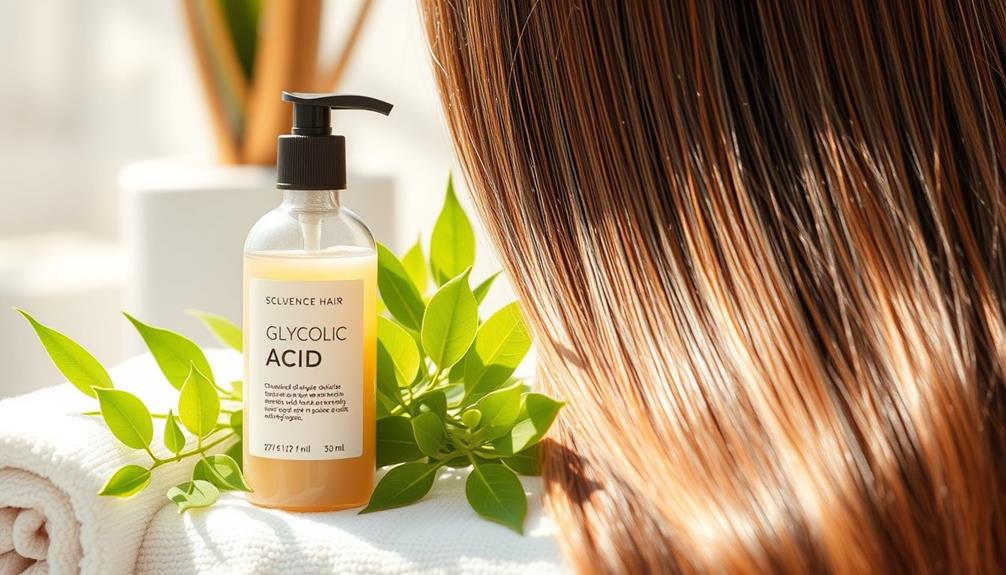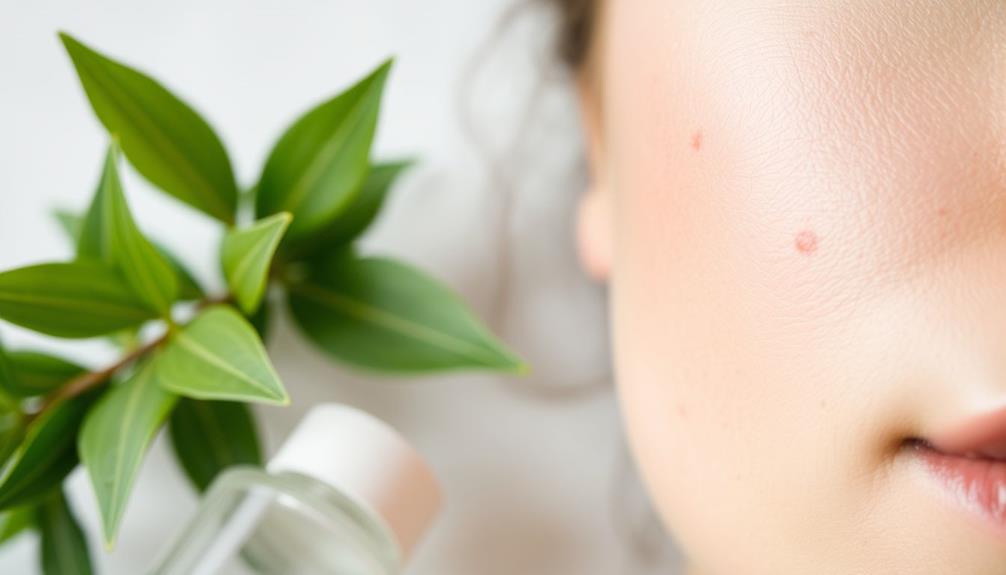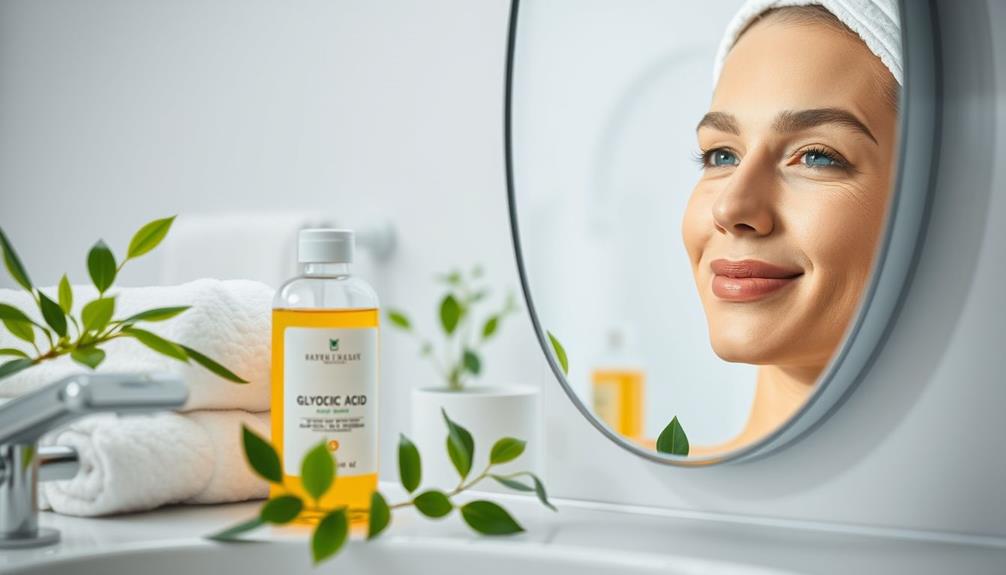Glycolic acid is a game-changer for your hair care routine. This powerful alpha hydroxy acid helps exfoliate the scalp, removing impurities and calcium deposits that can cause breakage. You'll notice enhanced softness, increased shine, and improved manageability after regular use. Plus, it boosts moisture retention, making your hair less brittle and frizz-free. To use it, apply a low-concentration serum or toner, massage it into your scalp, and let it sit for 20-30 minutes before rinsing. Just be cautious of potential irritation. If you want to discover more about its applications and alternatives, there's a lot more to explore.
Key Takeaways
- Glycolic acid exfoliates the scalp, removing impurities and calcium deposits, leading to healthier hair and reduced breakage.
- It enhances moisture retention, resulting in softer, shinier, and more manageable hair.
- The small molecular size of glycolic acid allows for deep penetration into hair cuticles, improving overall texture.
- Regular use can align hair cuticles, boosting shine through better light reflection and reducing frizz.
Overview of Glycolic Acid
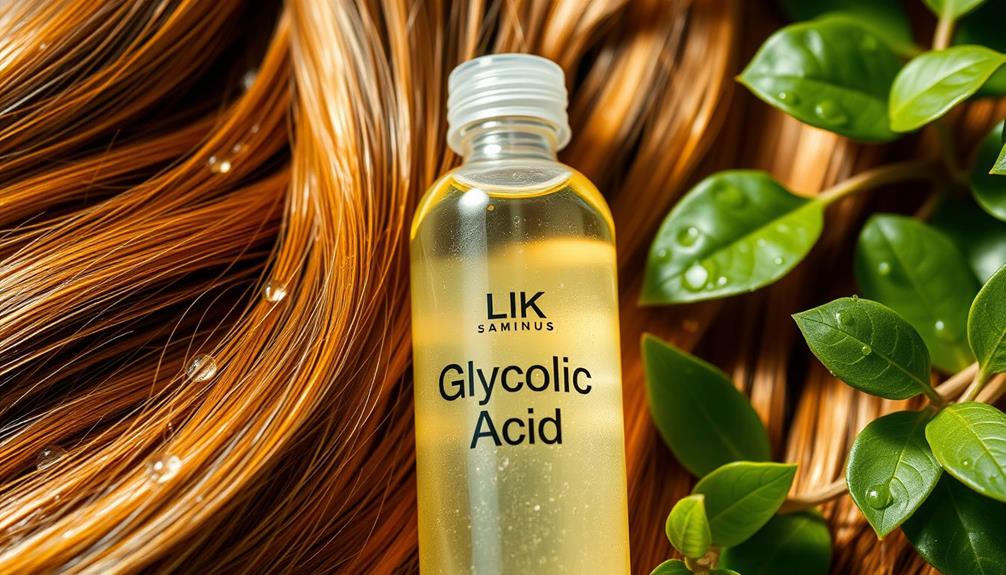
Glycolic Acid, an alpha hydroxy acid derived from sugarcane, is recognized for its powerful exfoliating properties and ability to enhance the health of both skin and hair.
As the smallest AHA, it penetrates the skin and hair cuticles effectively, making it a popular ingredient in various hair care products. You might be surprised to learn that, while most people associate glycolic acid with skincare, its benefits extend to hair health as well.
Incorporating crucial oils like lavender oil can further promote hair growth and vitality, complementing the exfoliating effects of glycolic acid.
In hair care, Glycolic Acid works by removing impurities and calcium deposits that can accumulate over time, potentially damaging your hair.
This gentle exfoliation promotes a cleaner scalp and healthier hair follicles, allowing for better growth and vitality. Additionally, it helps with moisture retention, leading to softer, smoother hair textures.
Despite its promising attributes, the exploration of Glycolic Acid in hair care is still limited.
The research into its effectiveness across different hair types is ongoing. However, as you consider incorporating Glycolic Acid into your hair care routine, it's important to look for products specifically formulated to harness its potential benefits.
Benefits for Hair Health
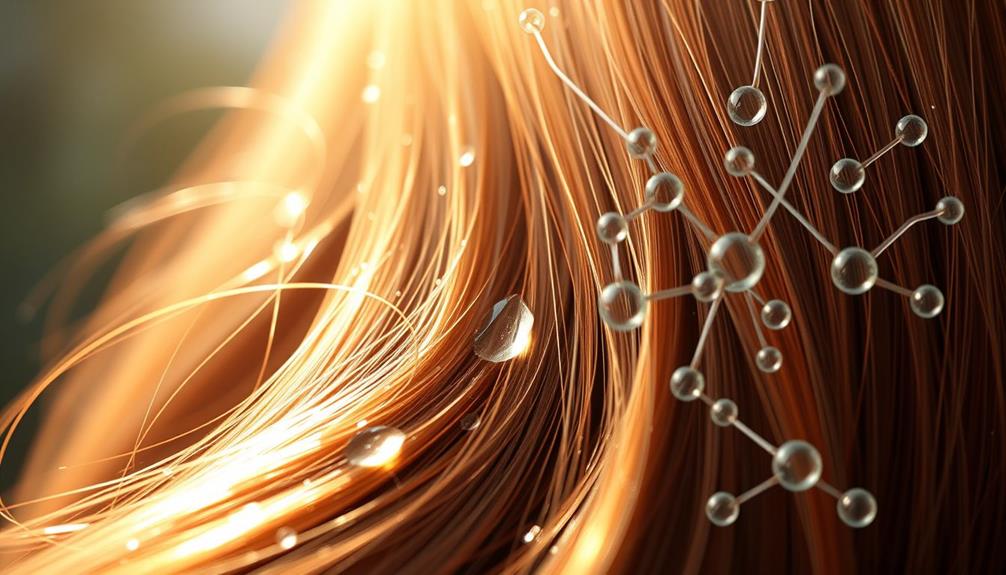
Incorporating glycolic acid into your hair care routine can lead to significant improvements in hair health, enhancing softness, shine, and overall manageability.
As the smallest alpha-hydroxy acid, glycolic acid penetrates hair cuticles effectively, removing impurities and calcium deposits that can damage your hair and cause breakage. Regular treatments, such as keratin treatments, can complement the benefits of glycolic acid by additionally smoothing and strengthening your hair.
By regularly using products with glycolic acid, you'll notice your hair retains moisture better, leading to improved softness and reduced brittleness.
One of the most impressive benefits of glycolic acid is its ability to increase hair shine. This happens as the acid aligns cuticles, allowing for maximum light reflection.
Moreover, when your hair is treated with glycolic acid, you'll find it has enhanced flexibility and reduced frizz. This results in a smoother texture that's easier to manage.
In addition, glycolic acid improves your hair's response to heat, raising the denaturation temperature and giving your strands better structural resilience.
With these benefits of glycolic acid, you can enjoy healthier, more vibrant hair that's easier to style and maintain. In addition to its hair-boosting qualities, glycolic acid also promotes scalp health by exfoliating dead skin cells and unclogging hair follicles. This can result in reduced dandruff and an overall improvement in the health of your scalp. With the many benefits of glycolic acid, incorporating it into your hair care routine can lead to significant improvements in the overall appearance and manageability of your hair.
Application Techniques
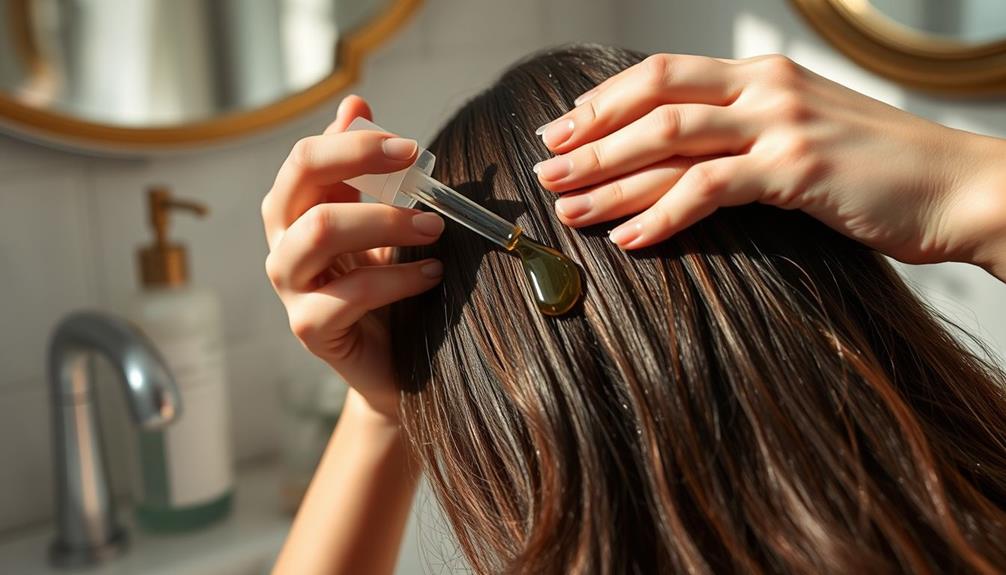
To effectively reap the benefits of glycolic acid for your hair, use a low-concentration serum or toner directly on your scalp and hair. Opt for a product with a concentration of 5-7%, which is excellent for exfoliation and moisture retention.
Incorporating a regular filter change can also enhance your overall wellness by improving the air quality in your environment. Start by applying a small amount and gently massaging it into your scalp, ensuring even coverage throughout your hair.
For best results, leave the glycolic acid treatment on for 20-30 minutes before washing it off. Evening applications are recommended to minimize sun sensitivity. To maintain healthy hair and improve hair softness over time, aim for consistent application once or twice a week.
Make sure the pH of your glycolic acid product is 3.5 or higher to enhance efficacy while avoiding irritation. Before diving in, conduct a patch test to check for any adverse reactions, especially if you have sensitive skin or existing scalp conditions.
Risks and Precautions
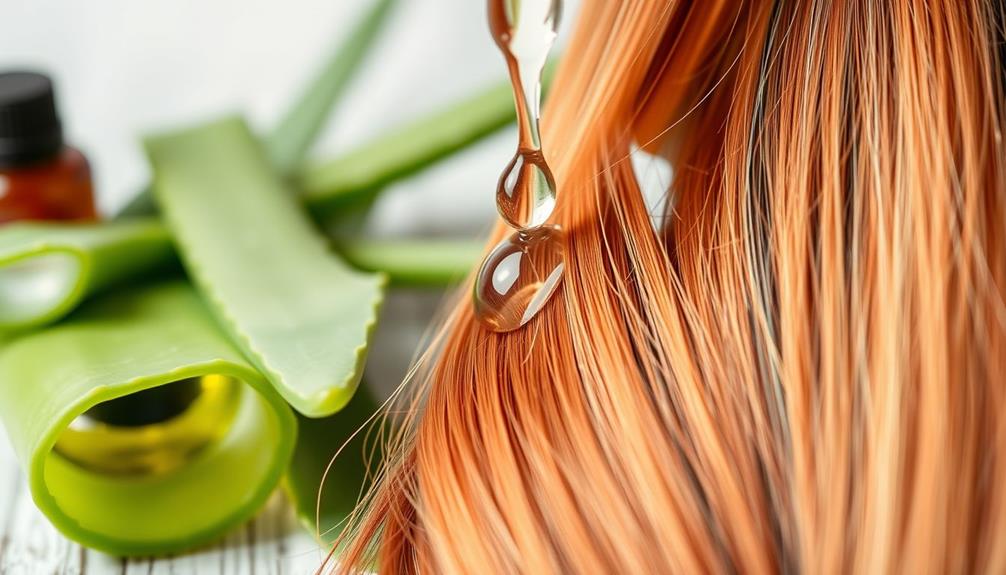
When using glycolic acid, it's important to be aware of potential side effects like scalp irritation and dryness.
You should also consider specific usage recommendations to avoid worsening any existing skin conditions.
Taking these precautions can help you enjoy the benefits while minimizing risks.
Possible Side Effects
Using glycolic acid on your scalp can lead to potential side effects, so it's important to be aware of the risks and take necessary precautions.
While Glycolic Acid is generally safe in concentrations below 10% and a pH of 3.5 or higher, some individuals may experience scalp irritation, redness, or itchiness. If you have sensitive skin, you might be more prone to these adverse reactions, and your scalp could become overdried, affecting your hair's health.
Additionally, glycolic acid can increase UV sensitivity, raising the risk of sunburn. It's essential to protect your scalp from sun exposure during and after application.
Rarely, some users report chemical burns or contact dermatitis, highlighting the need for careful application and monitoring.
If you have existing sores, sensitive skin, or dermatitis, it's best to avoid using glycolic acid altogether. Also, steer clear of using it after recent chemical treatments.
Always perform a patch test before applying any new product to your scalp, ensuring that your skin can tolerate it without adverse effects.
Usage Recommendations
Understanding the risks and precautions associated with glycolic acid is essential for ensuring safe and effective use on your scalp and hair.
When using glycolic acid in hair care, follow these recommendations to minimize potential issues:
- Concentration Matters: Stick to products with less than 10% glycolic acid and a pH of 3.5 or higher to reduce irritation.
- Patch Test: Always perform a patch test before applying glycolic acid to your entire scalp. This helps identify any allergic reactions or sensitivities to the product.
- Avoid Sensitive Areas: Don't apply glycolic acid to sores, sensitive skin, or dermatitis. It's also best to avoid use on very dry scalps or after chemical hair treatments.
- Sun Protection: Be aware that using glycolic acid increases UV sensitivity. Apply sunscreen to your scalp to prevent sunburn during treatment.
Alternatives to Glycolic Acid
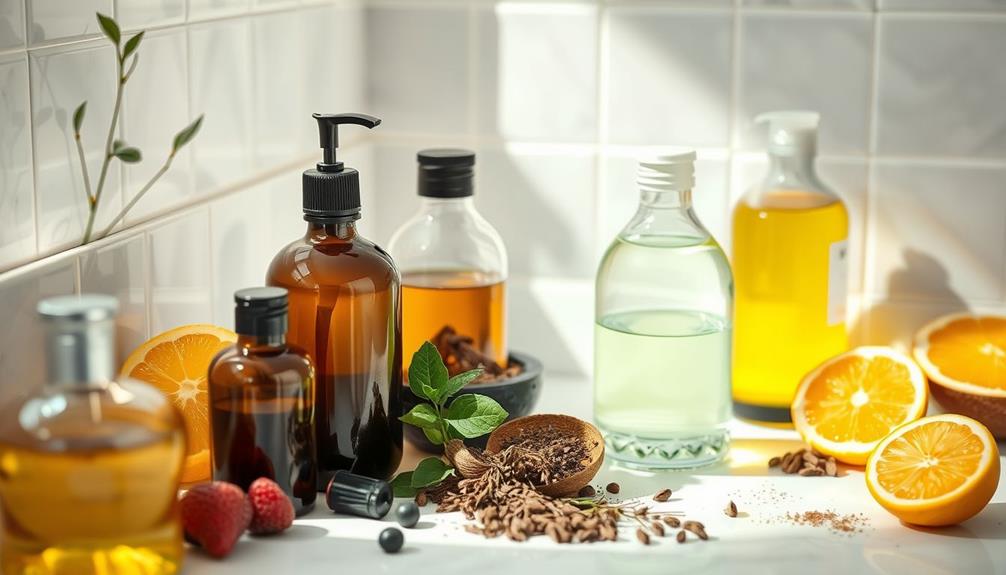
If you're looking for alternatives to glycolic acid, there are other exfoliating acids that might work for you.
You can also explore natural hair growth remedies that utilize essential oils and other holistic ingredients.
Each option offers unique benefits, so it's worth considering what fits your needs best.
Other Exfoliating Acids
When exploring alternatives to glycolic acid, you'll find a variety of exfoliating acids that cater to different hair and scalp needs. Each of these other exfoliating acids can address specific skin conditions while enhancing your hair care routine.
Here are four popular options to evaluate:
- Lactic Acid: A milder alpha hydroxy acid (AHA) that hydrates and promotes cell turnover, making it perfect for sensitive skin types.
- Salicylic Acid: A beta hydroxy acid (BHA) that penetrates deep into hair follicles, effectively treating oily scalp conditions and dandruff by dissolving oil and debris.
- Mandelic Acid: Derived from almonds, this acid has a larger molecular size, leading to slower absorption and making it gentler for reactive skin or hair.
- Citric Acid: Found in citrus fruits, citric acid balances the pH of hair products and boasts antimicrobial properties to enhance overall scalp health.
Natural Hair Growth Remedies
Natural remedies for hair growth offer effective alternatives to glycolic acid, providing various options to boost your scalp health and stimulate hair follicles.
One proven method is minoxidil, an FDA-approved topical treatment that promotes hair regrowth for both men and women, especially those with androgenetic alopecia.
If you're looking for an oral option, finasteride can help reduce hair loss by blocking the conversion of testosterone to DHT, but remember it's not recommended for premenopausal women.
Essential oils, like rosemary and peppermint, also work wonders. Studies show that rosemary oil can improve hair thickness and density, rivaling the effects of minoxidil after consistent use.
Additionally, anti-fungal shampoos with ketoconazole can combat scalp inflammation and conditions like seborrheic dermatitis, which often contribute to thinning hair.
Don't underestimate home remedies! Regular scalp massages and aloe vera can enhance blood circulation and nourish your scalp.
If your hair is damaged, these natural approaches can support healthier growth, making them worthwhile alternatives to glycolic acid in hair treatments.
Understanding Hair Loss Causes
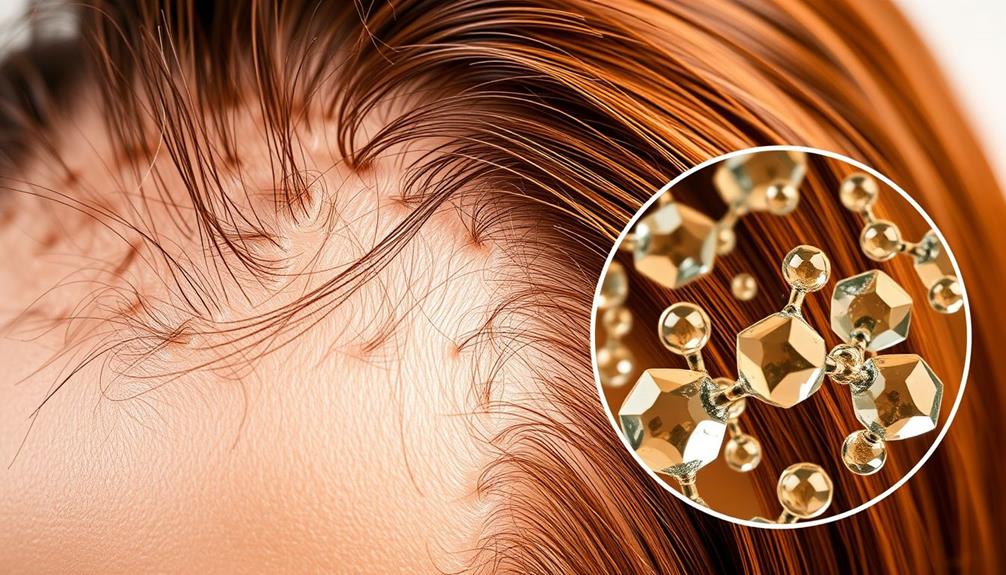
Understanding the causes of hair loss is essential, as various factors like genetics, stress, and certain hairstyles can greatly impact your hair's health. When you know the underlying causes, you can better address issues like hair breakage and treated hair. Here are four common causes of hair loss to evaluate:
- Androgenetic alopecia: This genetic condition affects both men and women, often leading to gradual hair loss starting in your 20s or 30s.
- Telogen effluvium: Triggered by stress, illness, or hormonal changes, this temporary shedding can result in noticeable thinning within months.
- Alopecia areata: An autoimmune disorder, it leads to sudden, patchy hair loss, impacting about 2% of the population.
- Traction alopecia: Caused by tight hairstyles like braids or ponytails, this condition can result in permanent hair loss if not addressed.
You should also be cautious of medication-induced hair loss, as some cosmetic treatments and drugs can exacerbate the issue.
Frequently Asked Questions
What Does Glycolic Acid Do to Your Hair?
Glycolic acid cleanses your hair by removing impurities and calcium build-up, enhancing shine. It boosts moisture retention, reduces frizz, and improves flexibility, making your hair smoother and easier to manage while strengthening its structure.
What Happens if You Leave Glycolic Acid on Too Long on Hair?
Leaving glycolic acid on your hair too long can feel like playing with fire. You risk scalp irritation, dryness, and brittleness. Stick to the recommended time to keep your hair healthy and vibrant.
What Are the Cons of Glycolic Acid on Scalp?
Glycolic acid can irritate your scalp, causing redness and itchiness. Overusing it might dry out your scalp and hair, making flakiness and brittleness worse. Always patch test to avoid potential chemical burns or dermatitis.
Does Glycolic Acid Break Hair Bonds?
No, glycolic acid doesn't break hair bonds. Instead, it interacts with keratin to enhance flexibility and strength, promoting healthier hair. You'll find it beneficial for improving overall hair structure without causing permanent damage.
Conclusion
Incorporating glycolic acid into your hair care routine can be a game-changer, offering numerous benefits like improved texture and scalp health.
Just remember, it's essential to use it wisely and take necessary precautions.
While it mightn't be the silver bullet for all hair concerns, it's certainly worth considering if you're looking to enhance your locks.
So, give it a shot and see how it can help you achieve the luscious hair you've always wanted!
